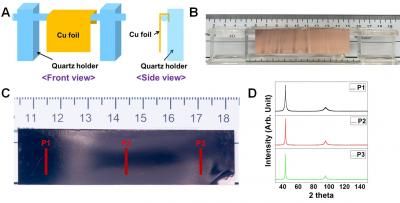New material could expand applications and lower costs for solid oxide fuel cells
Advertisement
A new ceramic material described in the journal Science could help expand the applications for solid oxide fuel cells - devices that generate electricity directly from a wide range of liquid or gaseous fuels without the need to separate hydrogen.
Though the long-term durability of the new mixed ion conductor material must still be proven, its development could address two of the most vexing problems facing the solid oxide fuel cells: tolerance of sulfur in fuels and resistance to carbon build-up known as coking. The new material could also allow solid oxide fuel cells, which convert fuel to electricity more efficiently than other fuel cells, to operate at lower temperatures, potentially reducing material and fabrication costs.
"The development of this material suggests that we could have a much less expensive solid oxide fuel cell, and that it could be more compact, which would increase the range of potential applications," said Meilin Liu, a Regent's professor in the School of Materials Science and Engineering at the Georgia Institute of Technology. "This new material would potentially allow the fuel cells to run with dirty hydrocarbon fuels without the need to clean them and supply water."
The research was supported by the U.S. Department of Energy's Basic Energy Science Catalysis Science Program.
Like all fuel cells, solid oxide fuel cells (SOFCs) use an electrochemical process to produce electricity by oxidizing a fuel. As the name implies, SOFCs use a ceramic electrolyte, a material known as yttria-stabilized zirconia (YSZ).
The fuel cell's anode uses a composite consisting of YSZ and the metal nickel. This anode provides excellent catalytic activity for fuel oxidation, good conductivity for collecting current generated, and compatibility with the cell's electrolyte – which is also YSZ.
But the material has three significant drawbacks: even small amounts of sulfur in fuel "poison" the anode to dramatically reduce efficiency, the use of hydrocarbon fuels creates carbon build-up which clogs the anode – and because YSZ has limited conductivity at low temperatures – SOFCs must operate at high temperatures.
As a result, fuels used in SOFCs, such as natural gas or propane, must be purified to remove sulfur, which increases their cost. Water in the form of steam must also be supplied to a reformer that converts hydrocarbons to hydrogen and carbon monoxide before being fed to the fuel cells, adding complexity to the overall system and reducing energy efficiency. And the high-temperature operation means the cells must be fabricated from costly exotic materials, which keeps SOFCs too expensive for many applications.
The new material developed at Georgia Tech addresses all three of those anode issues. Referred to as BZCYYb as shorthand for its complex composition, the material tolerates hydrogen sulfide in concentrations as high as 50 parts-per-million, does not accumulate carbon – and can operate efficiently at temperatures as low as 500 degrees Celsius.
The BZCYYb (Barium-Zirconium-Cerium-Yttrium-Ytterbium Oxide) material could be used in a variety of ways: as a coating on the traditional Ni-YSZ anode, as a replacement for the YSZ in the anode and as a replacement for the entire YSZ electrolyte system. Liu believes the first two options are more viable.
So far, the new material has provided steady performance for up to 1,000 hours of operation in a small laboratory-scale SOFC. To be commercially viable, however, the material will have to be proven in operation for up to five years – the expected lifespan of a commercial SOFC.
"We don't see any problems ahead for fabrication or other issues that might prevent scale-up," said Liu. "The material is produced using standard solid-state reactions and is straightforward."
The researchers don't yet understand how their new material resists deactivation by sulfur and carbon, but theorize that it may provide enhanced catalytic activity for oxidizing sulfur and both cracking and reforming hydrocarbons.
In addition to its tolerance of sulfur and resistance to coking, the BZCYYb material's conductivity at lower temperature could also provide a significant advantage for SOFCs.
"If we could reduce operating temperatures to 500 or 600 degrees Celsius, that would allow us to use less expensive metals as interconnects," Liu noted. "Getting the temperature down to 300 to 400 degrees could allow use of much less expensive materials in the packaging, which would dramatically reduce the cost of these systems."
Beyond its use in fuel cells, the material developed by Liu and his team – which also included Lei Yang, Shizhong Wang, Kevin Blinn, Mingfei Liu, Ze Liu and Zhe Cheng – could also be used for fuel reforming to feed other types of fuel cells.
Though the technology for solid oxide fuel cells is currently less mature than that for other types of fuel cells, Liu believes SOFCs will ultimately win out because they don't require precious metals such as platinum and their efficiency can be higher – as much as 80 percent with co-generation use of waste heat.
"Solid oxide fuel cells offer high energy efficiency, the potential for direct utilization of all types of fuels including renewable biofuels, and the possibility of lower costs since they do not use any precious metals," said Liu. "We are working to reduce the cost of solid oxide fuel cells to make them viable in many new applications, and this new material brings us much closer to doing that."
Other news from the department science
Most read news
More news from our other portals
See the theme worlds for related content
Topic World Battery Technology
The topic world Battery Technology combines relevant knowledge in a unique way. Here you will find everything about suppliers and their products, webinars, white papers, catalogs and brochures.

Topic World Battery Technology
The topic world Battery Technology combines relevant knowledge in a unique way. Here you will find everything about suppliers and their products, webinars, white papers, catalogs and brochures.
































































